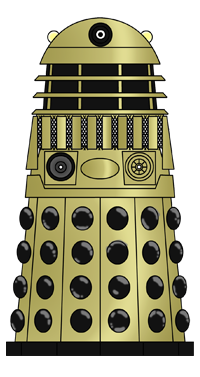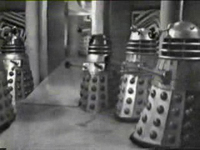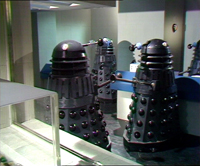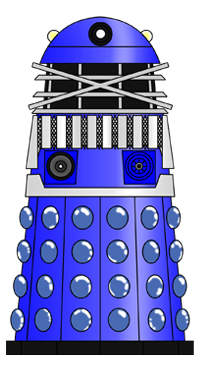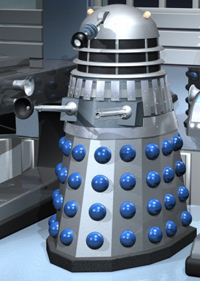of the Daleks
of the Daleks
of the Daleks
of the Daleks
of the Daleks
of the Daleks
Generation 01, Generation 02, Generation 03, Generation 04.
At the very end of the Kaled-Thal war, Davros revealed the Mark Three Travel Machine to the assembled members of the Kaled Science Elite. It was shortly after this reveal that the name "Dalek" was first used to refer to the Kaled mutant and its habitation casing. This machine was the first of the casings to feature an internal power supply, although external sources of power could still be drawn upon to supplement this supply. This was the most commonly used casing utilised throughout the history of the Dalek race up until the Time War against Gallifrey, and a number of cosmetic variations to the basic design have been sighted over the years. Variations included the number of rings on the eye-stalk, detail between the arm sockets and different designs of luminoscity dischargers. Following the Dalek Civil War, the basic design of the casing was improved on by implementing elements of the design of the Mark Four casing used by Davros' Imperial Dalek Faction.
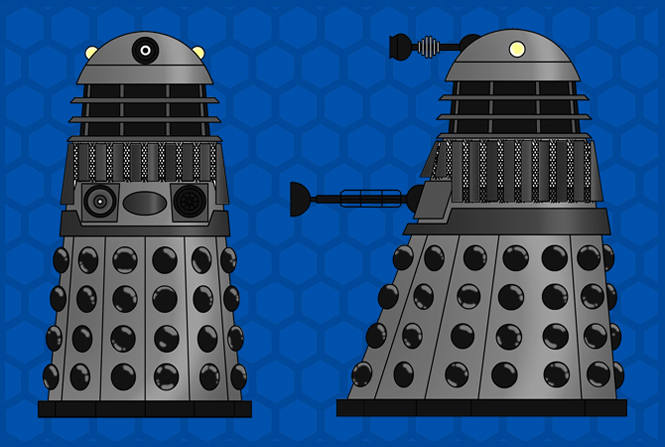
This casing featured stronger armour than either of the previous designs. This was primarily due to Davros' new vision of the Dalek as a one-mutant tank as well as a means of survival for the Kaled people. Exchangeable manipulator arms made the casing a versatile tool for its occupant. The standard "sucker" attachment, seen on the vast majority of Dalek units included a Data-probe that could be extended to interface with Dalek technology. This probe was also capable of adapting to interact with alien technology. The sucker utilised suction and magnetics to allow the Dalek to carry objects with this attachment. The left attachment was almost exclusively a sophisticated energy weapon. Both arms could be swapped for other tools when required.
As with previous designs, fifty-two (52) sensor globes fed environmental data to the central computer. These had been updated to include simple life-sign detectors. The occupant knew when life is around, if not precisely where it was.
This construction of the Dalekanium shell was such that the occupant could withstand submersion in liquid and burial under solid materials. The casing did not protect against sudden extremes of temperature, but the casings systems were capable of withstanding changes that occurred slowly. Evidence also suggests that the mutant within a Mark Three casing could be drowned if liquid was forced into its life support chamber.
As with the Mark Two Travel Machine, the computer systems were located within the dome section of the casing. This system was more advanced than that of the Mark Two casing and was continually upgraded during the course of the casing's use throughout history. This advanced computer system allowed the mutant quicker access to data and included an internal communications link with other units in addition to a distress signal / homing beacon that was activated either by the mutant itself or when the dome’s seal was broken without the correct code being sent. The habitation module sat within the middle "neck" section of the casing and the mutant had direct control of whichever arm attachments were installed. Beneath the habitation module was located the nutrient tank that fed and supported the casing's occupant.
Within the skirting section, an advanced power generator was situated at the heart of the machine. This generator was supplemented by external panels around the shoulders that were capable of extracting energy from the environment, in particular solar radiation. In addition, Psychokinetic energy was used as a power source when traditional means fail, though this only provided enough energy to power the motive unit and life-support systems of the casing. The motive unit of the Mark Three Casing allowed for faster movement than previous designs and the increase in available power reserves allowed the motive unit to lift the machine up to twenty five centimetres from the surface along which the unit was travelling. The unit could thus travel up uneven surfaces by raising and tilting backwards and propelling upwards.
A prototype of this casing was seen amongst early Pioneer fleets which contained an advanced battery, but no internal power plant. Energy must be collected from external sources and the battery charged. The Travel Machine would then be able to operate independently for a limited amount of time. This casing was issued to Generation 02 explorer units to enhance their efficiency when away from the main Dalek fleet.
The Chase, Genesis of the Daleks, War of the Daleks, Dalek Empire 01-04. Prototype – Power of the Daleks.
